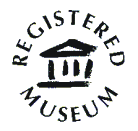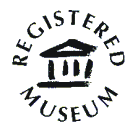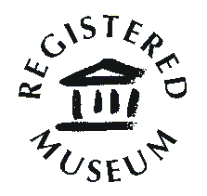

Newsletter
Issue 58 May 2007


~~~ NEWSDESK ~~~
Table of contents
Newsdesk, and dates for your diary 2
Museum Update - 4
Mills of the Wandle on Film 9
Trials of a Mayor 6
GoP - Lost habits of the workplace 8
The Wandle on Film 9
A day in Surrey with Wm Morris 11
The New Colossus 14
The Skeletons of Spitalfields 14
Visits to the Museum have been consistent throughout the Spring months. During the Easter holidays we had several children and families from the Wallington area. The children were doing a project about the River Wandle and came to us for a source of information, and we were glad to be of help. In April we had a party of students from Merton College - the Skills for Working Life Group for students with special needs. They enjoyed their Textile Workshop with our Education Team very much, and even more so when Mary delivered their handiwork to them personally at the College.
*******
The visit will be on Thursday July 2 at l.00pm for the guided tour costing £3 per person, and it is proposed that we meet at 12 noon in their café where refreshments are available. The House Mill can be reached via the District Line to Bromley-by-Bow from where it is a short walk. We already have 12 members on our list and can take up to 18. Please ring the Museum on 020 8648 0127 or e-mail us at <curator@wandle.org> to book your place
******
Volunteers
We had a very successful Quarterly Volunteers' Lunch Meeting on April 25 when eighteen volunteers attended. During the meeting it was decided to book a date for our proposed visit to the House Mill at Bromley-by-Bow: see the February Newsletter for information about the history of the Mill.
Training for Museum Accreditation
Several volunteers have been busy attending courses leading towards our becoming an Accredited Museum by 2009. Courses come under four headings: Museum Management, Engaging with Audiences, Customer Care and Managing Collections. Meg our Volunteer Curator, Jacquie our Volunteer Archivist, Eric our Health & Safety at Work Officer and myself have now attended seven of these courses which fortunately have been free.
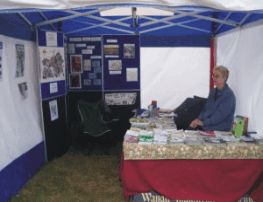
Outreach
Several volunteers have recently given their time to talk to outside community groups which is always valuable in promoting the Museum. These include Carers' Support Groups, the Merton & Sutton branch of the Police Society and the Carshalton Society.
The National Trust Fair - 'A Country Affair at Morden Hall Park. This year we had to pay £150 for a stall provided by the organisers Stage It. There were no charity stalls allowed and our stall was at reduced cost. We decided to go as an experiment to see whether we would make any profit. The stall in a row of similar covered stalls proved windproof and rainproof and was in a good position within the body of the fair. Apart from a long heavy rain-shower on Bank Holiday Monday the weather was good, and the site was crowded and business brisk. The overall amount taken was £257 which was very good.
Our thanks to all the volunteers who helped make this event a success.
Dates for your Diary
- Saturday June 16th - Opening of new Exhibition "Young's Brewery: the End of an Era" at 11.00am. Invitations to be issued.
- Saturday June 23rd - Wimbledon Village Fair. Help needed please.
- Sunday June 24th - Wandle Valley Festival. Events all along the river; Museum open 12.00 to 4.00. Mary will be block printing in the Chapter House all day.
Subscriptions
Some people have still not paid their subscriptions for 2007. A renewal form is included with this newsletter. Prompt payment would be appreciated.
Sheila Harris 15/5/2007
Museum Update
Much is happening at the Museum at present, and, although no single item is momentous, there is a real feeling of activity and progress. Some snippets are included in this update, but this is far from complete. In no particular order:
Museums generally.
The gloomy warnings in last February’s Newsletter have lightened, to some extent. The Carshalton lavender fields now look safe, with the development program now concentrating on a different site. Not quite so much relief at the other end of the Wandle. The closure of the Wandsworth Museum still goes ahead in October this year, with the collection being dispersed amongst the libraries. The Hintze Foundation has stepped in to ensure there will still be a Wandsworth Museum, probably sharing the current West Hill Library building with the De Morgan exhibition. However the timing is uncertain, and we fear for the jobs of the current Museum employees, and the loss of know how which scattering them among the various libraries will entail
Curatorial and Archive.
As mentioned in Newsdesk, Meg Jackie and Sheila have been continuing their program of attendance at seminars and conferences, helping to focus progress with both displays communication administration and archive.
It is now clear we need to upgrade our computer and transfer the considerable amounts of information we already have in digital form into a managed database which conforms to the new standards.
Mr. Norman Langridge contacted us via e-mail re an 8mm film he had made some years ago, of the mills in working order.
The film was given to the Screen Archive SE. and following dialogue with them and Mr. Langridge, we are hoping that we will be able to have a copy of this film on DVD to show visiting children. At the time of writing this report, I am awaiting confirmation from Screen Archives that this is possible. One of his photographs appears in the Wandle Guide on page 46. His email was so informative and interesting, we obtained his permission to repeat it in the Newsletter, and it appears below at p 9
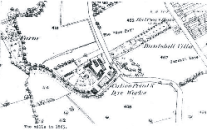
Also contact from Mr Leon Malhomme de la Roche, whose family have owned Duntshill Mill since the 1940's, and who is now involved in restoring it. We hope to be able to assist him in any research he needs, and we will all benefit from the knowledge another mill of the Wandle has been saved or preserved.
We have had two approaches from houseowners on the line of the old Croydon Merstham and Godstone Iron Railway, looking for help in establishing their properties in relation to it. Again, not only are we pleased to help, but each contact adds to our own knowledge.
Dave Roberts, who many of you will know as the accountant to many of the Voluntary bodies operation in this area, has let us copy a quite extraordinary article he acquired from ebay. An extract appears below. It first appeared in a US magazine called ‘The Century’ in 1886. It tells of the visit that the writer, Emma Lazarus, paid to William Morris a couple of years earlier. As a US citizen, Emma’s reporting of the visit helps give the outsider’s view of the great man. More than that, however, Emma was herself a person of note. She was greatly interested in the plight and welfare of the underprivileged, especially within the workforces of her era, so her comment on Morris’ similar views has great relevance. Even more than that, she wrote words which are known by almost all English speakers - she is the author of the poem ‘The New Colossus’ which is inscribed at the base of the Statue of Liberty, and contains the famous lines
‘Give me your tired, your poor,
Your huddled masses yearning to breathe free,’
The whole poem is not always reproduced so I make no apology for setting it out on page 14 below, together with an extract from the article in question (p9).
Finally, with the Chelsea Flower Shower upon us again, a recent article in The Times started ‘Britain’s oldest garden grotto has been excavated in the grounds of a Surrey mansion. Built in the reign of Elizabeth I as part of an elaborate Renaissance layout, it was decorated with mineral specimens and seashells; the Queen herself visited the estate on many occasions to enjoy its French-inspired splendours.’ It goes on to relate that this was at Carew Manor in Beddington. Yet another sample of the wider cultural influence of the Wandle Valley?
Ravensbury
Dear All,
Thought you may be interested in this pic for your Newsletter or Young’s Exhibition.
It was taken at last years Mitcham Carnival and it was one of the last outings of Young’s dray horses before brewery was closed. When posing for a picture, one of the horses took a fancy to the chain and tried to pull it off - nearly strangling me in the process. As you can see, Peter Moore was blissfully unaware!!
Regards,
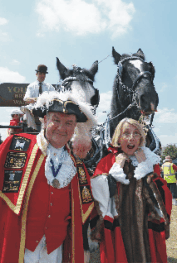
Geraldine.
Very slowly things are beginning to happen. We are still awaiting input from the legal department of LB Merton approving the HLF’s suggestions which would enable us to launch a fresh bid. Hopefully that will happen soon. In the meantime the planning enforcement officers have had one meeting on site at Ravensbury and now have, we hope, the bit between their teeth!
Funding
We remain hugely grateful to LB Merton for continuing to fund our existence in Vestry Hall Annexe, and are happy to report that the threatened cut in that funding did not materialise. The first instalment for the current year has already been received.
Publications
We have co-published with The Wandle Valley Festival the River Wandle Wildlife Guide written by Tony Drakeford. This is now on sale, but its formal launch will be at the WVF event on 24 June. It is currently priced at £1.95 - all proceeds from this print going to WVF. Everyone should have one! You can get them from us, or from the Wheelhouse.
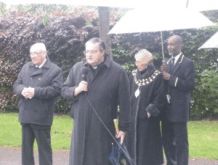 Andrew Wakefield, speaking at the tree
planting at the Canons
Andrew Wakefield, speaking at the tree
planting at the CanonsIt has been a pleasure to have Cllr Geraldine Stanford as Mayor of Merton this year, and we look forward to continuing to work with her in her other capacities as a Trustee of the Priory Trust, and organiser of the Mitcham Carnival. It was at that event last year that one of the Young’s dray horses took a fancy to her Chain of Office. She has been kind enough to let us reproduce her a photograph of that incident, and we can only praise her for facing up to the same horse the following day at the WVF - albeit at a safer distance!
One of the Mayor’s last official functions was the treeplanting at the Canons in Mitcham to mark the bicentenary of the abolition of the slave trade. Here she is listening to our chair Andrew Wakefield addressing the group (wearing his Interfaith partnership hat).
By the time you read this we will have a new Mayor of Merton, and look forward to working with him/her in the future. We are very grateful that the new Mayor will honour us by opening our Summer Exhibition before going on to the Mitcham Carnival.
Outreach
Although expensive as mentioned in Newsdesk we had a productive time at the May Fair in Morden Hall Park. As always, although the book sales we generate are important, and the bad weather in the middle of the Monday did not help, it is one of our major outreach events, when we meet people who would otherwise be unaware of us. We look forward to hearing further from one particular visitor who worked for Young & Co in his early years, and who told some hair-raising tales of working practices from those days. He has promised to try and write some of these down, and let us have them for archive. We are grateful to him for the GoP which appears below.
Education
This is a busy time of the year, with various visits to the Museum planned, and Mary taking her block printing to the Chapter House, not only for the WVF, but supporting Museum of London on the following day, who entertain Bond Primary School on the following day - all 200 or so of them.
Glimpse of the Past
This was related to us by a visitor to our stall at the May Fair.
As a young man, he joined an engineering company. On being shown round the machine room on his first day, he noticed that almost every lathe operator had what looked like a night light burning on the bench beside him. On closer inspection, these were uniformly made out of old tobacco tins, filled with fuel such as paraffin, and with a hole punched in the lid through which a short bootlace had been pushed to act as a wick. What were they for? All the men were smokers, and most of them smoked pipes. By keeping these burning all day they saved on matches, and could relight their pipes at will without any significant pause from their work.
Not only does this story create an incredibly Dickensian image, it tells us a lot about working conditions and social habits of an era not so long past. With England becoming a smoke free zone on 1 July, this will retreat even further into history.
Merton Abbey Mills Update
There is not much to report, especially as the proposed wind turbine has not yet been erected. An exploratory hole for its foundations has been dug, and inspected by MoLAS. However there is some problem with the hinging mechanism which allows it to be erected, and there is no certain date for the to be solved.
There was a large tent full of MAM stalls at the May Fair again, and we understand they are travelling to Clapham for next bank holiday weekend, and again to Hampton Court for the August bank holiday. Anything which spreads the word must be to the good.
May 29th sees the launch of Dave Saxby’s major opus published by the Museum of London - ‘The Augustinian Priory of St Mary Merton, Surrey: excavations 1976 to 1990' - at an event to be held on 29th May at the Museum of London. There should be a large contingent from the area in attendance. It is quite astonishing to think that Dave himself has been excavating here for over 20 years.
Ed, May 07
Mills of the Wandle on Film
We were surprised and delighted to receive the following email, out of the blue,
from Norman Langridge. It is reproduced here in full with his permission:
As a person borne in Wallington (but having now lived at Littlehampton for many many years,) and having a great interest in watermills, I am taking immense pleasure from reading the accounts by McGow of the various Wandle Mills, many of which I visited when making an amateur 8mm film of Old Surrey Watermills using Hillier's book of the same title. I was extremely fortunate that my then youthful inexperience was such that it persuaded the owners of the mill at Deed's Eagle Leather Works, at the end of Willow Lane, Carshalton, to instruct their engineer to see what he could do to get the large waterwheel working for me. Fortunately, the engineer was an enthusiastic fellow and despite the fact that he had to replace most of the wheel's scotches, he did get the wheel turning once more, probably for the last time before that whole mill structure was lost forever. This is the mill complex that McGow covers under the names of Logwood Mill and Mitcham Mill, Carshalton. I was told by the engineer that just after WW2 the wheel had been rebladed using sheet metal from Morrison Air Raid Shelter tops. Substantial indeed! Even then building up a head of water for my filming had to be done with extreme care to ensure that those downstream were not deprived of it, as Grove Mill was still using their waterwheel for commercial purpose. Backing water upstream then presented no problems, at least, not to millers. The large waterwheel had been used to generate electricity (DC I think) and as it was still belt connected, bring back the wheel to life, also generated some power. It had a rotary speed control of the two ball shaped spinning weights that were connected to the sluice controlling water to the wheel. Water shortage was evident on the Wandle in that along side the generator was a vertical single cylinder steam engine!
It is a pity that McGow did not deem it desirable to include NGRs in his reports, although the OS maps help when shewn.
As a child I well recall trips to The Grange at Beddington with pleasure and I am sure that at one time the Wallington Bridge Mill buildings were in use by Helm Royal Chocolate.
The people occupying the premises you now use as a museum were a sports equipment manufacturer/supplier and they too were kind enough to run one of the two wheels for my camera, stating that they did not turn them often as the bearings needed replacing.
I did not manage to capture any movement of the Snuff Mill in Morden Hall Deer Park, but a colleague did using a 9.5mm camera. Unfortunately such was the precarious state of the metal blades that quite a lot disintegrated. I believe that a later attempt was made to reblade the wheels and turn them, but local vandalism put paid to that effort I am told.
Likewise, the wheel at Libertys was not available for movement at the time of my filming, but I gather that it is turned now, it forming a feature in the local redevelopment.
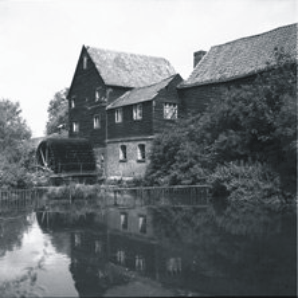 Deed's Mill
Deed's MillCopies of the still photographs I took of Deed's Mill in Willow Lane were left with the Sutton Library although I still retain the negatives, and my movie film now resides at the Southeast Film and Video Archive at the Records Office, West Sussex County Council in Chichester.
I am quite willing to scan the negatives for your museum if you think they may be of interest. SEFVA gave me a copy of my movie on VCR cassette, but I am considering asking them if I can get a copy done with more professional equipment on to a DVD where I may be able to edit it, and add some sound.
Good luck with your project. Perhaps I can find my way up to the museum soon. I am pleased that the Wandle has come back to life again in the nature sense.
And then in a further email he wrote:
Many thanks for your kind remarks, I am pleased that my memories have found a kindred spirit. I will keep in touch via the website to see how the museum progresses and once up and running will pay a visit. In the meantime I will pursue the transfer of the film to DVD, especially as it was the Wandle that provided most of the movement. To close I insert an image that I shall never forget and one that should never have been allowed to disappear, flood improvement scheme or not.
We look forward to receiving a copy of the film when it has been transferred to digital media. Only by storing such treasures in a number of different depositories can we be sure that these valuable records are not lost forever by mistake. Ed
A Day in Surrey with William Morris.
By Emma Lazarus 1886 - An extract
EARLY in July the roses fairly run riot in the garden-like county of Surrey; all
along the railway the little village stations are walled with thickly flowering vines,
or hedged with blooming bushes. From one of these small, bevined stations in a
deep cutting of the Croydon road, we started — a party of four — on a soft, gray
midsummer morning for a day at Merton Abbey. Merton Abbey the very name
suggests visions of venerable Norman arches and cloisters, the roofless aisles and
topless columns of some ruined seat of ecclesiastical power. In point of fact the
Abbey whither we were bound is merely a utilitarian factory that supplies the
market- wares for Morris & Co.'s decorative art shop in Oxford street. "‘Tis five
miles from Croydon, one mile from Wimbledon," Mr. Morris had said, in directing
us where to find him; and we had chosen to take the shortest part of the little
journey by rail, and to drive in an open carriage from Croydon to Merton. Here the
enamored Nelson used to come to bask at the feet of his Delilah. Merton Place,
which he gave to Lady Hamilton after her husband's death, is close by the Abbey,
and revives the memory of that passionate intrigue, with its dramatic interplay of
glory, shame, and beauty. The drive was not remarkably picturesque, leading at
first through dead-and-alive provincial streets lined with the various ugliness of
the suburban villa, and then issuing beyond the town to pass through a flat and
sufficiently commonplace landscape. But to American eyes no bit of rural England
can be devoid of interest and charm; the most ordinary objects seem under a spell
to bewitch us back into the dream-world of a previous existence. An ivied wall,
a pebbled brook, a thatched and lattice-windowed cottage, a single-arched stone
bridge, an English daisy, a field of
blood-bright poppies, take on a
glamour that is not their own, but is
borrowed from a thousand haunting
memories of Shakspere and
Wordsworth, of Spenser and Shelley,
of Milton and Keats. The American
sentimental traveller in England could
supply curious notes to the expounders
of t
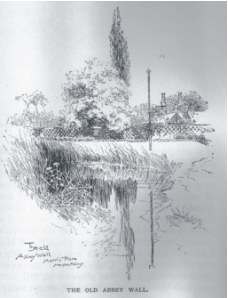
he doctrine of heredity or the
believers in the transmigration of souls.
Was it he, or his remote forefather,
who stood centuries ago precisely
under this knotty- limbed oak, amid
these crisply hedged, velvet swarded
meadows, opposite that identical
gabled cottage of stone, smothered in
its wealth of black-green ivy? How
intimately he knows it all, how inexpressibly dear to him is the soil beneath his
feet, the ever-changing mist and cloud-veiled sky above his head, the atmosphere
of luxurious repose, the half- tearful, half-smiling, maternal look in the eyes of
Nature, welcoming him to his ancestral home! Thus we drove through the tame
and level fields of North Surrey with that subdued
thrill of perfect physical and emotional content, that
"sacred and home-felt delight," which we had come
to associate with the very grass and air of England.
The English friends who accompanied us had grown
used to our easily excited enthusiasm, and appeared
them selves to enjoy the familiar landscape through
the medium of our fresher
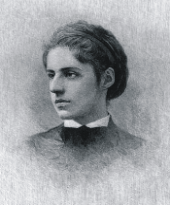 Emma Lazarus
Emma Lazarus
transatlantic vision.
Feeling that we must be nearing our goal, we began
to inquire of the passers-by our way to the Abbey,
and before long we approached a plain, low, double
house set back and some what raised from the level
of the road, where we saw, framed against the black
background of one of the upper windows, the cordial
face and stalwart figure of William Morris, clad in a dark-blue blouse. Before we
had alighted he was at the gate to
receive us, welcoming us with his great,
hearty voice and warm hand-grip. "The
idle singer of an empty day" might sit
for the portrait of his own Sigurd. He
has the robust, powerful form of a
Berserker, crowned with a tall, massive
head, covered with a profusion of dark,
curly hair plentifully mixed with gray.
His florid color and a certain roll in his
gait
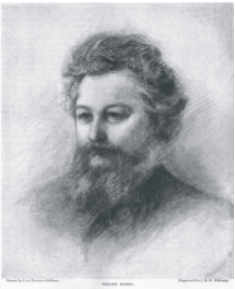
and a habit of swaying to and fro while talking suggest the sailor or the yeoman, but still more distinctly is the poet made manifest in the fine modeling and luminous expression of the features. An indescribable open-air atmosphere of free dom and health seems to breathe from his whole personality.
The Editor writes: The whole article goes on for some 8 pages, and can be seen at the Museum. This extract was indeed written as a single paragraph. There are a number of interesting images in the article, and the one above was chosen to complement Emma’s rather fulsome description of Morris, whilst the first one was just new to me.
Our grateful thanks to Dave Roberts for allowing us to copy this.
The New Colossus
Emma Lazarus, New York City, 1883
Not like the brazen giant of Greek fame
With conquering limbs astride from land to land;
Here at our sea-washed, sunset gates shall stand
A mighty woman with a torch, whose flame
Is the imprisoned lightning, and her name
Mother of Exiles. From her beacon-hand
Glows world-wide welcome; her mild eyes command
The air-bridged harbor that twin cities frame,
"Keep, ancient lands, your storied pomp!" cries she
With silent lips. "Give me your tired, your poor,
Your huddled masses yearning to breathe free,
The wretched refuse of your teeming shore,
Send these, the homeless, tempest-tossed to me,
I lift my lamp beside the golden door!"
The Skeletons of Spitalfields
This was the title of one of the Chronicle programmes on BBC television some years ago and the following explains why I was interested in it.
When the crypt of Christchurch in Spitalfields was being cleared of rubble and lead coffins to make room for a day centre, the local factory inspector was concerned about the possibility of lead inhalation by the people clearing the crypt. My employer, Fry's Metals Limited, was on his list of companies who provided an atmospheric sampling service and they were approached. At that time I was the hygiene officer for the company (in addition to other duties) and I was asked to take atmospheric, site and personal samples there. Because of the possible risk of infection of smallpox from any of the remains and the time required for the necessary vaccination to take effect, the site would have been cleared, so I never went. Subsequently it was found that was no smallpox risk.
This now is the interesting part of the story. Because of the information that was given on the coffin plates about the corpse inside, age at death etc the, it was found that the most accurate way to determine the age of human remains is to examine the teeth roots. The more transparent they are the older the person was at death. The usual method at that time was to examine the skeletal remains. This was found be less accurate, human remains were considered to be much younger at death than they were found to be by correlation of the teeth roots and the coffin plates.
Many of the remains were of Huguenot origin, including one of a matriarch of the Courtauld family, Louisa Perina Courtauld, nee Hosier. She came from a family who were silk merchants, but her husband was a silversmith. She died in 1807. The Courtauld family are now known in the textile industry. Subsequently her skeleton was cremated and the ashes were placed in the cemetery with other members of her family whose headstones were already placed along a wall in the cemetery. A headstone for her was placed in a suitable vacant space along the wall
Eric Shaw
March 2007
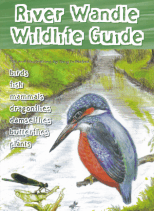
This is the cover of the new book co-published by us with Wandle Valley Festival. It is available from us and from the Wheelhouse, price £1.95.
The author, Tony Drakeford, is known to many of us from his Nature Notes in local newspapers, and his knowledge and enthusiasm for our river is apparent from this booklet.
It is hoped this will be the first of an informative series to be co-published each year.
The Vestry Hall Annexe, London Road, Mitcham, Surrey CR4 3UD
Tel: 020-8648-0127
~~~~~~~~~~
OPEN: Every Wednesday 1 ~ 4 pm;
First Sunday of each month 2 ~ 5 pm.
~~~~~~~~~~
The Museum is also open to schools and groups by appointment.
~~~~~~~~~~
Admission: Adults 50p, Children & Senior Citizens 20p
The Wandle Industrial Museum would like to point out that the views of contributors to this newsletter are not necessarily the views of the Museum. We would be happy to give the right to reply to anyone who finds the content contentious.
